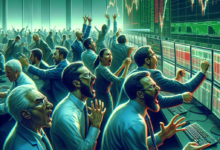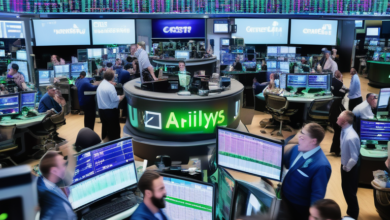Stock Market Today: Dow Drops 775 Points on Day of Global Sell-Off

Key Highlights
- The Dow Jones Industrial Average plummeted 775 points, reflecting a significant market downturn driven by concerns about the U.S. economy and global economic uncertainty.
- Weaker-than-expected jobs data for July raised alarms about potential economic slowing, prompting investors to seek safer assets.
- Technology companies experienced a notable decline, with Intel facing its worst day in 50 years due to disappointing earnings and a suspended dividend.
- Energy and retail sectors also witnessed sharp declines as investors factored in the potential impact of a weakening economy on consumer spending and oil demand.
- Global markets responded with sell-offs of their own, with European markets closing lower and Asian markets bracing for impact amid heightened global uncertainty.
Overview of Today’s Market Turmoil
The stock market had a tough day, with the Dow Jones Industrial Average dropping 775 points. This drop is part of a larger global sell-off happening in recent days. Investors are worried due to several bad signals, such as U.S. jobs data that came in lower than expected and ongoing global uncertainty.
The Nasdaq Composite also fell more than 10% from its recent high, entering correction territory. This sell-off highlights concerns that high interest rates, meant to fight inflation, may lead the U.S. economy into a recession.
Key Indexes Suffer Major Drops Amidst Global Sell-Off
It was a tough day on Wall Street. All major indexes closed a lot lower. The Dow Jones Industrial Average, which seemed strong at first, dropped nearly 775 points. That is a big loss of over 2%.
The Nasdaq Composite also fell hard. This index focuses on technology companies and dropped more than 3%. It is now in a correction phase. This recent drop is due to investors thinking about the value of fast-growing companies. Rising interest rates have made them reconsider their choices.
The S&P 500, which shows how the whole U.S. stock market is doing, also took a hit. It fell almost 3%, losing a lot of gains made this year. This drop shows that many sectors were affected, from technology to consumer goods and financial services.
Factors Contributing to Today’s Market Decline
Today, the market fell sharply after the release of U.S. jobs data that was weaker than what experts expected. This news raised worries about the economy’s health and made people speculate on what the Federal Reserve might do next. The report showed that fewer jobs were added than economists had predicted, which stirred up concerns.
Earlier in the week, more reports pointed to a slowdown in the manufacturing sector. This sector is important for measuring economic activity. It raised doubts about how strong the current economic growth really is.
As investors processed this information, many worried that the Federal Reserve’s strong interest rate increases, aimed at reducing inflation, might have gone too far. They feared these moves could push the economy into a recession. This uncertainty about what the Federal Reserve might decide to do next, especially about possible rate cuts, added to the market’s drop.
Detailed Analysis of Dow’s 775-Point Plunge
The Dow Jones Industrial Average fell 775 points. This drop shows growing worries on Wall Street about a slowing economy. The jobs data released on Friday was below what people expected. This information added to fears and caused heavy selling.
Before Friday, the Dow did better than the Nasdaq, which focuses more on tech. But the fall on Friday shows that no part of the market is safe from worries about a possible economic slowdown. This big drop highlights how shaky investor confidence is and increases fears of a possible recession in the future.
Sectors Leading the Dow’s Downfall
The Dow fell a lot, and many sectors were affected, but some were hit harder. This shows worries in financial markets about how much money companies might make in a weaker economy.
Technology companies were especially hurt in this drop. These companies often lead market sentiment. Investors are worried about slower economic growth. With tech stocks already valued high, they took another look at profit estimates, causing many to sell their shares.
The drops in financial and energy sectors also helped push the Dow down. Financial institutions are worried about a slowing economy, especially after recent bank failures. Concerns about lower energy demand as the economy slows down also hurt energy stocks.
Comparison with Past Market Performances
Friday’s big drop was a strong reminder of how quickly the market can change. The Dow fell by 775 points, making it one of its worst days recently. This drop shows how sensitive the market is to new economic data and how fast feelings about the market can shift.
|
Period |
Dow Jones Performance |
|
Last Year |
+ 7.3% |
|
June Quarter |
+3.4% |
|
Friday |
-2.4% |
The size and speed of Friday’s decline, especially after a time of stability, raised questions for many investors and analysts. They wonder if this is just a short-term dip or if it marks the start of a longer drop. How the market does in the next weeks is key to understanding what this downturn means for market sentiment.
Major Companies Hit Hard in Today’s Trading
Friday’s market drop surprised many. It hit different sectors hard, causing major companies to lose a lot. Tech stocks took the biggest hit. This was due to fears about slower growth and high prices. Apple did report good earnings, but it still faced losses.
Other sectors felt the strain too. Energy companies suffered as oil derivatives fell. This drop was linked to worries about less demand because of a slowing economy. Retailers also faced struggles, as investors were concerned about how a weak economy might affect how much people spend.
Tech Giants Experience Significant Losses
As worries about a possible recession grow, technology companies, which often show how investors feel about the market, faced some of the biggest losses. This downturn shows a change in equity markets. Investors are changing what they expect for growth and how much risk they are willing to take during this uncertain economic time.
Intel’s big drop made things worse. The company shared poor earnings reports and said it would stop paying dividends, which made investors even more nervous. This news affected the whole tech sector. It shows how even big name companies are struggling in today’s economy.
Because of all these factors, investor confidence fell further. Technology stocks, which have helped drive market gains in the past few years, saw a sharp decline.
Energy and Retail Sectors Also Face Sharp Declines
Beyond tech, energy and retail also had a tough day. Oil prices fell after recently rising due to tensions in the Middle East. Worries about a possible economic slowdown and how it might affect energy demand put pressure on the sector.
Retailers faced a hard market too. Investors thought about how a weaker economy could hurt consumer spending. A drop in spending on non-essential items, caused by inflation and job security concerns, could hurt retailers’ profits, leading to a decline in the sector.
The drop in both energy and retail shows how fears about the U.S. economy are affecting different areas. This is bad news for companies that depend on strong consumer demand and steady economic growth.
Global Markets React to U.S. Sell-Off
Global markets faced more ups and downs due to a drop in U.S. stocks. Investors kept a close eye on Wall Street as it took a big hit, raising worries about economic strength. The potential response from the Federal Reserve about interest rates also affected how the market felt. The Dow Jones Industrial Average fell sharply, similar to other major indices that showed a careful attitude. There was a lot of uncertainty as market players waited for signs from central banks around the world. This came amid increasing trade issues and geopolitical risks. The sell-off highlighted how connected financial markets really are.
European Markets Close Lower Following Dow’s Drop
European markets took a hit on Friday, following Wall Street’s sharp drop. The news of the Dow’s fall heightened worries about the global economy. The pan-European STOXX 600 index fell significantly, and all major sectors ended the day in the red.
In this tough environment, investors faced geopolitical issues and high inflation. They decided to be careful because of the U.S. market correction. Concerns grew that a slowdown in the U.S. economy might spill over and cause more problems in Europe.
As the markets closed, many traders and analysts felt uneasy. They wondered if this downturn was the start of a bigger problem or just a short-term dip in a generally upward trajectory.
Asian Markets Brace for Impact Amidst Global Uncertainty
As news spread about the sell-off in the U.S. stock market, Asian markets were getting ready for what might come next. People were already worried about the state of the global economy as it moves into the third quarter. The chance of a recession in the U.S., along with rising tensions around the world and ongoing concerns about inflation, made investors uneasy.
Adding to the worries, the Bank of Japan just changed its monetary policy. This change raised questions about what might happen with global interest rates. Since Japan plays a big role in the world’s economy, investors everywhere pay close attention to any major moves from the central bank.
Now, as Asian markets are about to open, everyone will be watching how these markets react to the troubles in the U.S. stock market and local economic data. Traders and analysts are looking for signs that could show wider effects and ongoing selling pressure.
Economic Indicators Influencing Market Behavior
Friday’s big drop in the market shows how much economic data affects how investors feel. The jobs data was not as good as expected. This raised worries about the labor market, which is important for economic growth. It also reminded everyone that the fight against inflation is still ongoing.
To make things worse, earlier reports showed trouble in the manufacturing sector and a drop in consumer confidence. All these indicators together have made people afraid of a possible recession. This has led investors to think twice about risks and look for safer places to put their money.
Latest Employment Data and Its Effect on the Market
The jobs data released on Friday greatly affected the market. It caused big changes on Wall Street and sparked a worldwide sell-off. The report showed that job creation slowed down a lot. Nonfarm payrolls did not meet what economists expected. This signals the labor market might be cooling down.
This surprise weakness in the labor market is important for economic growth. It worried investors who were already concerned about the Federal Reserve’s strong interest rate hikes to fight inflation. There are fears about rising unemployment and ongoing inflation, raising worries of a possible “stagflation” situation.
To add to the worry, there was a small rise in the unemployment rate. This suggests there may be some slack in the labor market. It also raises concerns that the Federal Reserve’s actions to fight inflation could be leading the economy towards a recession.
Inflation Concerns and Federal Reserve’s Stance
Lingering worries about inflation are a major factor influencing market behavior. Friday’s sell-off highlighted the stress between the Federal Reserve’s fight against inflation and fears of a possible recession caused by its strong interest rate hikes.
The recent interest rate hikes by the Federal Reserve aim to reduce inflation, but they also raise fears of slowing the economy too much. This balancing act is tricky. The goal is to achieve a “soft landing” by controlling inflation without causing a recession, which keeps investors worried.
The market’s response to Friday’s economic data shows the high stakes in the Federal Reserve’s decisions. Investors are paying close attention to hints about what the central bank will do next, especially concerning the speed and size of future interest rate changes.
Frequently Asked Questions
How Does This Compare to Previous Market Sell-Offs?
This sell-off is similar to the market dips we saw last month. However, the size of this drop is worrying, especially after many companies reported better quarterly results than expected. Weakening nonfarm payrolls and rising initial jobless claims have made fears even stronger. This downturn seems like it could be more serious than the ones we had before.







